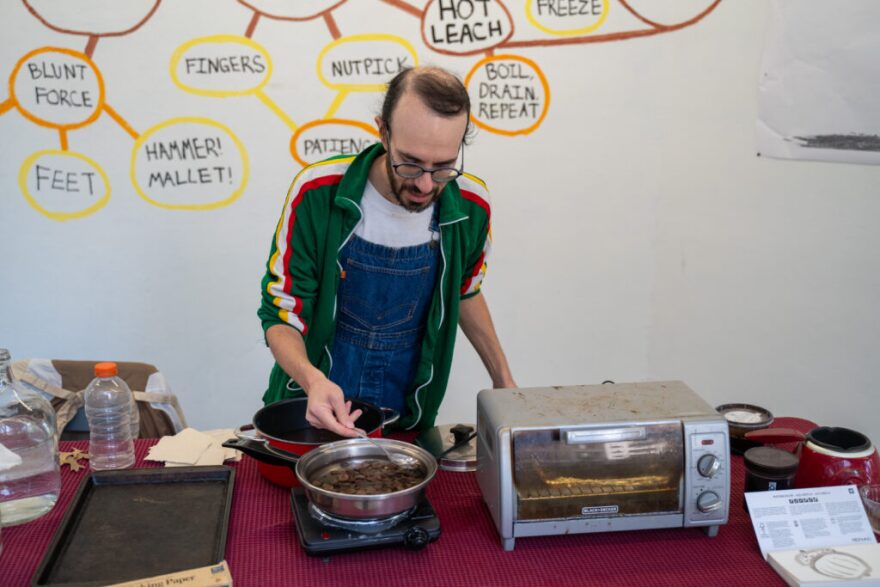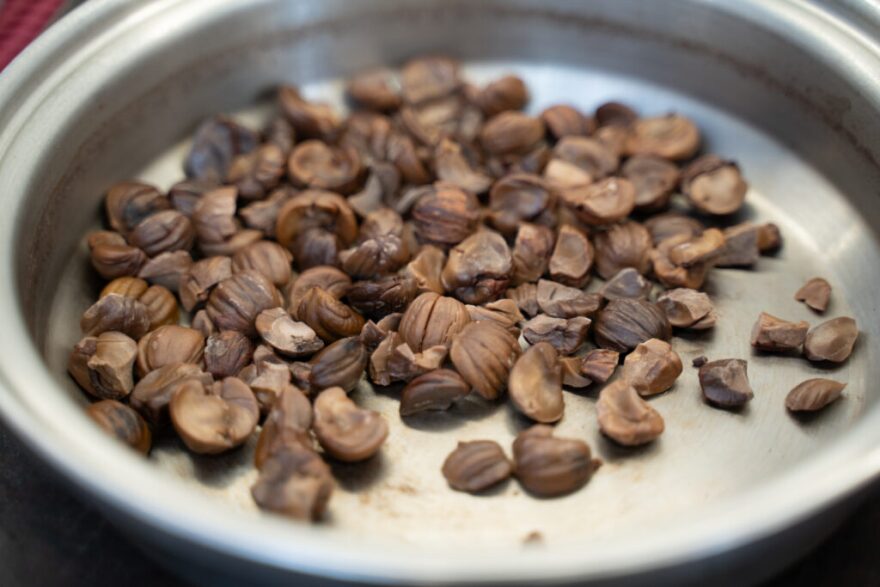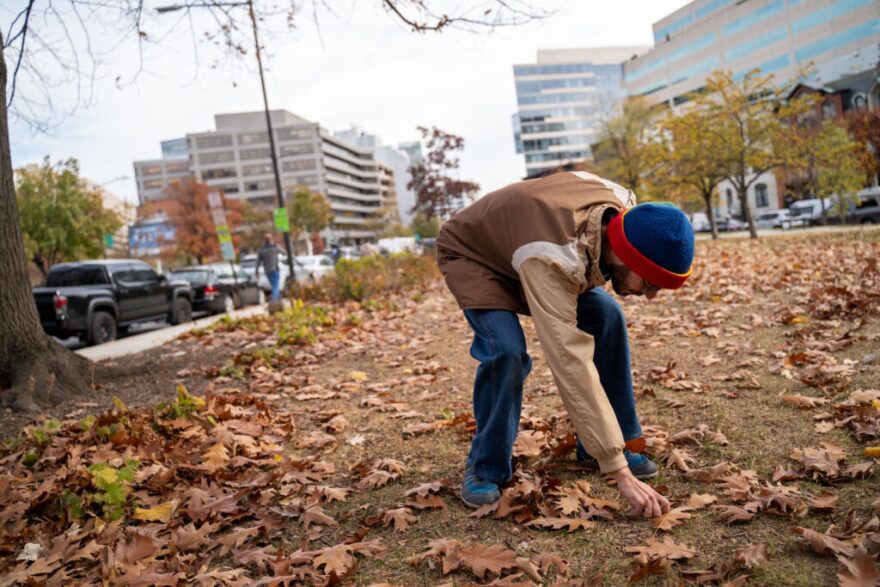Read the original story on DCist's website.
Depending on where you live, you may have noticed an unusual number of acorns dropping from oak trees recently. It appears to be a mast year in much of the D.C. and Virginia region — when oaks produce a bumper crop of their hard, bitter nuts.
Local artist and educator Shawn Shafner is celebrating with an exhibition and event series called Acornucopia!
It’s a “festival of all things acorn,” Shafner says, “an earthly garden of acorn delights.”
Shafner hopes a closer examination of this ubiquitous underfoot item will get people to better appreciate the humble acorn — both its role in nature and as a source of nourishment. Shafner is currently an MFA student at George Washington University, where the gallery exhibition is located.
He tends to get a little obsessed with things most of us would maybe rather not think about. Previously, he spent years on something called The POOP Project, which included a solo show (An Inconvenient Poop) and a documentary (Flush).

“A lot of what that work is essentially about is redeeming something that we think of as a waste product, but that actually is incredibly nourishing for our environment,” Shafner says.
Likewise, acorns are also seen as urban waste.
“They’re something that we step on, we step over, we’re annoyed by. They hit our cars, they clog our drains,” he says. “But they’re actually this incredibly beneficial component of an ecosystem in terms of regenerating forests and in terms of food.”
At the gallery on the GWU campus, Shafner has a long table set up with all he implements needed to prepare acorns for eating. Anyone who walks in (including this reporter) can give it a try, from cracking acorns all the way through leaching them, roasting them and grinding them into flour.

For many Native Americans, acorns were a staple. Like other nuts, acorns are highly nutritious. They’ve long been part of cuisine around the world, pretty much everywhere that oak trees grow natively, including Europe, North Africa, and much of Asia.
In Korea, for example, there’s a popular dish called dotorimuk.
“I grew up eating it, and it is something that my mom would prepare for special occasions,” says D.C.-based chef Caleb Jang. He and his wife Roren Choi ran the restaurant Magpie and the Tiger in Petworth.
Since it closed last year, they do catering and pop-ups around the city. Dotorimuk is a savory jelly — delicious, Jang says, even if it’s unfamiliar to the modern American palate: “This has been a very common way to use the acorn in Korean food. It has been used for hundreds of years as a food source.”

Jang is teaming up with Shafner for an acorn cooking demonstration and tasting later this month. There will also be a native Piscataway farmer and a local forager on the panel.
Jang says as a chef, he sees part of his job as introducing people to dishes and ingredients they may not have tried before. “Specifically in this case with the acorn, it’s delicious. So I don’t think it would take very much convincing once you get the person to take a bite of it.”
In the gallery, Shafner and I put a couple of handfuls of husked acorns into a pan of water to boil. After just a few minutes, the water turns dark brown, as the bitter tannins leach out. Tannins are chemical compounds that occur naturally in many foods — they’re present in black tea and red wine, for example — and they impart bitterness and astringency. In unleached, raw acorns, the tannins are so strong as to make the nuts inedible to humans.
After boiling the acorns for about a half an hour, and changing out the water a few times, we taste the nuts.
“Still bitter. But the flavor that I can taste under the bitter is very good: roasted, carmelly,” Shafner says. “I’m going to spit it out now. But I think soon these will be ready.”

While oaks may seem ubiquitous – witness the carpet of acorns around the D.C. region this year – the trees are actually struggling. In forests, deer devour seedlings, making it hard for trees to reproduce. In landscaped urban areas, people often prefer more ornamental trees. And many mature oaks are reaching the end of their lifespans, stressed by climate change and urban living.
Alexis Dickerson, senior director of community conservation at the nonprofit Potomac Conservancy, works on a project called Tomorrow’s Trees, which asks volunteers to collect intact acorns to be used to grow seedlings for reforestation efforts.
“We are trying to raise awareness in communities that they have this really highly valuable resource right at their fingertips, and then we invite them to be part of the solution to a local ecological problem,” Dickerson says.
Currently, there’s an active acorn drop-off site at GWU.

Dickerson, who is also participating in the Acornucopia! panel, says growing more native oak trees will have wide-reaching effects on the environment.
“Many people are surprised to find out that in the Potomac River watershed tree loss is actually one of our biggest challenges and lowest scoring indicators of river health that we’ve been measuring. This initiative is really responsive to that huge ecological problem.”
At the exhibition, visitors can learn to differentiate acorns by oak species: Shafner has collected acorns from all 17 oak species around the GW campus. In the gallery, there are acorns everywhere — some are displayed on plates, with formal place-settings. There are also various acorn games, including one that invites visitors to throw acorns at tiny toy cars.

Finally, after about an hour, we give the leeched acorns one last taste.
“It’s getting there,” Shafner says.
Indeed, the nuts have an almost sweet taste, their caramel scent filling the gallery.
Even if acorns are never a major part of the American diet, Shafner wants to get people thinking differently about our food system.
“It’s not some separate thing in a box that I have to buy in a store. It doesn’t need to be vacuum sealed and double wrapped in plastic. It’s right there — I literally picked it up from the ground, in some cases from the gutter. It came in its own package. So that ultimately is like what’s really at the heart of it, to help us feel like we belong. We and the squirrels, we’re just living in, and of, and with this world,” Shafner says.



